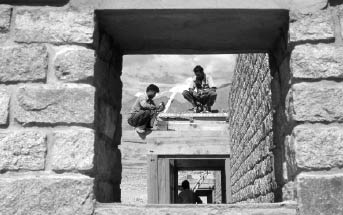Ladakh Revealed
by Albert Chao

On September 13, the University at Buffalo School of Architecture and Planning will host a lecture by Francesca Galeazzi. A sustainability consultant for Arup Associates in London, UK, Francesca has been a part of the Druk White Lotus School (DWLS) in Ladakh, India (referred to as Little Tibet), which has garnered international recognition for sustainable design.
Galeazzi received her masters in both architecture and environmental engineering from the University at Ancona in Italy. Since 2000, she has been working for Arup, a global firm comprised of designers, engineers, planners and business consultants, on DWLS. The individuals working with DWLS, including Galeazzi, are on a semi-voluntary basis. By 2003, Galeazzi acted as resident engineer/architect in Ladakh to help supervise construction.
The school began with a request from the people of Ladakh, and also His Holiness the 14th Dalai Lama. The hope of the school was to continue Tibetan Buddhist traditions while also preparing for the 21st century. In 2002, the DWLS received the World Architecture Award for Best Green Building, Best Asian Building and Best Education Building.
Galeazzi’s work opens a stimulating exploration of cross-cultural possibilities in both design and collaboration, and will go hand-in-hand with the upcoming visit and lecture by the Dalai Lama on September 19 at the University at Buffalo.
Speaking with Galeazzi personally, she opened up enthusiastically to her experiences in Ladakh. “The design and construction of the school emphasizes understanding of local culture and also involving the people of Ladakh,” she explained.
With half the population of Ladakh Buddhist, the relationship with the people became an essential part of the design process. “It is a community project rather than just a school. Working with the Dalai Lama and also with their spiritual leaders, they welcomed us into their community. There were no real barriers.”
Communication was easy because, for the most part, everyone spoke English. Collaboration also developed as many of the villagers volunteered their own time in constructing the school.
Ladakh, located in a remote Himalayan mountain desert area, is cut off by snow for half the year. Winter temperatures go down to 30 degrees below zero Celsius, while the summer sun melts the snow, creating fertile valleys. In these extreme conditions, there were many challenges to creating a sustainable design. In response, the design strategy was to keep things simple and in line with traditional construction methods.

“The school is also about coming up with appropriate developments and changes,” Galeazzi said. “Things can improve without necessarily adopting the Western ways.” For example, the traditional dry latrines were modified to ventilated improved pit (VIP) latrines, thus reducing flies and odor problems. “We included the traditional latrine without changing too much. Now they look to this design as the new standard.”
Other various technology and structural advances were used in tandem with traditional building techniques. Materials, whenever possible, were from local renewable resources, and included stone, mud mortar, mud bricks, timber and grass. The building’s design also focused on maximizing solar potential, which included passive solar heating, natural ventilation, natural lighting and solar energy.
When asked about her role as both an architect and environmental engineer, Galeazzi commented, “There is always a discussion between architecture and engineering. Part of the design process took place in London but much of the details, such as gates, kitchens, lanterns, were designed in Ladakh.”
The education curriculum at the school also provided future generations a bridge to their tradition and history. “The school actually teaches Tibetan, which is not taught at other schools. Traditional dances and cooking are also taught.”
When asked what she missed about Ladakh, Galeazzi replied, “Afternoons drinking tea and just talking to people. They put butter in their tea also, as a result of such dry weather. It tastes quite awful.” She also reminisced on the difference in culture: “[In Ladakh] the people find happiness in basic things, like food and shelter. People seem to be more fulfilled.” In contrast to the fast-paced drive of London and other Western cities, in Ladakh, “There is no rush. Things are simpler. And yet they still manage to be efficient. We seem to have lost this.”
Galeazzi continues to work at Arup Associates and currently is working on sustainability strategies for Stratford City, UK, for the 2012 Olympic Games. She has since visited Ladakh annually, except this year when she will be coming to Buffalo instead. She is also presently studying for her masters of fine art at the Central Saint Martins School of Art and Design in London, UK.
As for Ladakh, new economical, sustainable projects are being addressed. Enterprising Ladakh, a collaboration by Ladakh Autonomous Hill Development Council, Drukpa Trust and Druk Padma Karpo Educational Society and Secmol, is a project to ensure the successful development of Ladakh that is also conscious of tradition and culture.
Documentation of the DWLS has been organized into an exhibition, entitled Building Cultures: Druk White Lotus School: A Sustainable Model for Education and Design. Curated by Dean of UB School of Architecture Brian Carter, the exhibition will be open from September 16 through September 23 at the UB Art Gallery, Center for the Arts. There will also be an accompanying catalog entitled Building Cultures that is being published by UB School of Architecture as a part of buffaloBOOKS series.
Galeazzi’s lecture will be held on September 13 at the University at Buffalo South Campus in Crosby Hall Room 301 beginning at 5:30pm.
Design Matters is presented in association with the UB School of Architecture and supported by a fellowship endowed by Polis Realty.
|
Issue Navigation> Issue Index > v5n36: Three Men in a Room (9/7/06) > Ladakh Revealed This Week's Issue • Artvoice Daily • Artvoice TV • Events Calendar • Classifieds |









 Current Issue
Current Issue